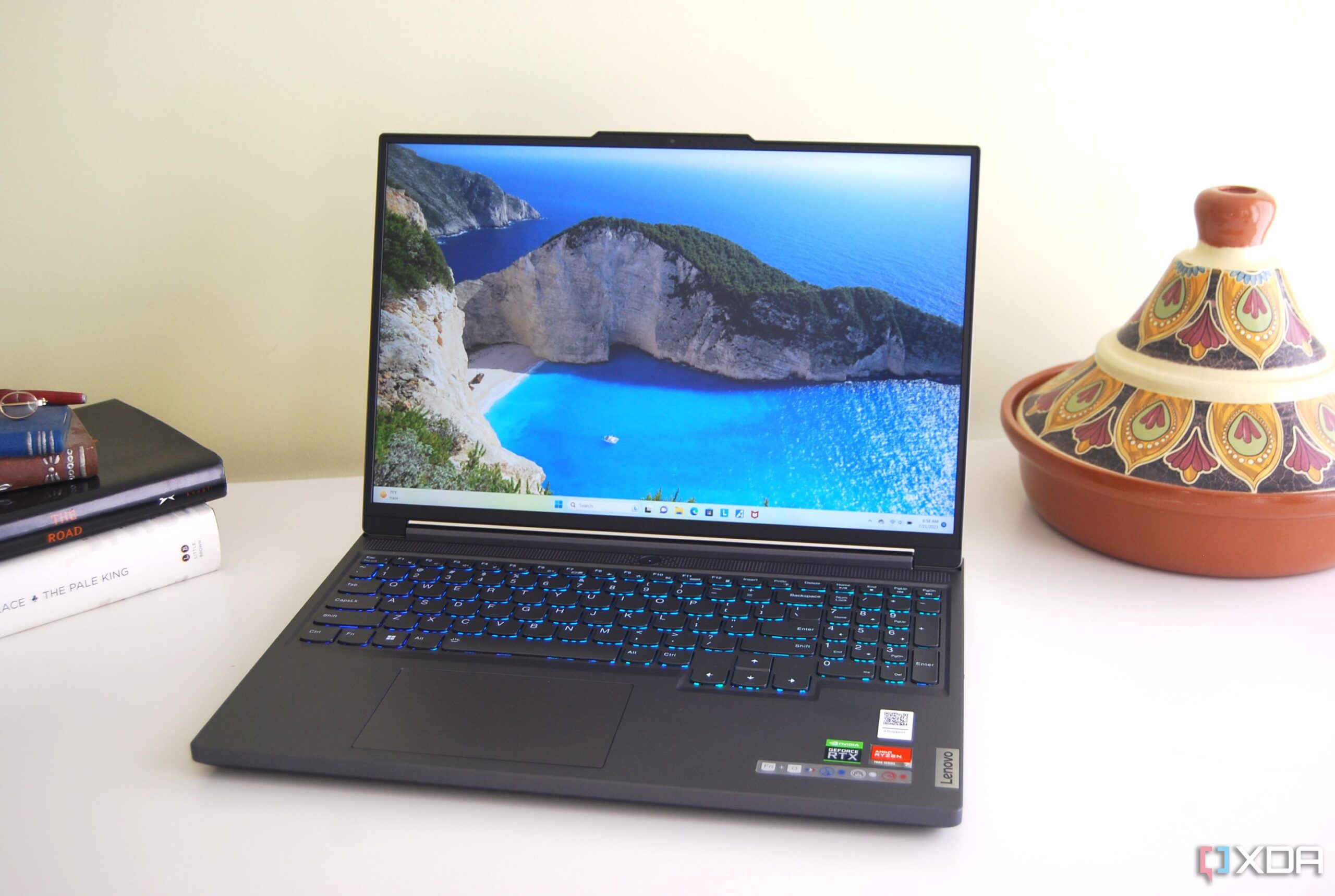
Lenovo’s Legion series of gaming laptops offers some of the best gaming PC hardware available on the market today. The Legion Pro 7i (Gen 8) that we recently reviewed currently sits at the top of our picks for the overall best gaming laptop, but it’s certainly not the only Legion laptop worth your attention.
Whereas the “Pro” segment of the Legion series offers the best experience (and thus the most expensive price tag), Lenovo’s “Slim” Legion laptops aim to cut down on the weight, thickness, and cost to deliver a more portable package that can nevertheless keep up with modern games and creative apps. The Legion Slim 5 (Gen 8) clearly cut some corners to keep the price down — the laptop’s base is plastic, there’s no per-key RGB lighting, and the battery tops out at 80Wh, — but I’ve really enjoyed my time with the relatively compact gaming laptop. It puts up strong numbers in both synthetic benchmarks and real-world testing, and it manages to keep itself from throttling.

Source: Lenovo
Lenovo Legion Slim 5 16 (Gen 8)
Thin and portable Legion laptop
$1075 $1300 Save $225
The Lenovo Legion Slim 5 (Gen 8) for 2023 is a worthwhile alternative to its more premium Legion Pro siblings, offering up comparable performance and cooling in a slimmer and more affordable package. You will have to live with some cut corners when it comes to design and features, but it doesn’t skimp on power and display, two categories that count the most.
- Storage
- 512GB M.2 PCIe 4.0 NVMe SSD, two M.2 slots, upgradeable
- CPU
- AMD Ryzen 7 7840HS (8 cores, 16 threads)
- Memory
- 16GB DDR5-5600, dual SODIMM slots, upgradeable
- Operating System
- Windows 11
- Battery
- 80Wh, supports Rapid Charge Pro
- Ports
- Two USB-C 3.2 (Gen 2), two USB-A 3.2 (Gen 2), RJ45 Ethernet, HDMI 2.1, 3.5mm audio, SD card reader
- Camera
- Front-facing 720p, eShutter
- Display (Size, Resolution)
- 16 inches, 2560×1600 (QHD+), 16:10 aspect ratio, IPS, 300 nits, AG, 100% sRGB, 165Hz, Dolby Vision, AMD FreeSync, Nvidia G-Sync, TÜV Low Blue Light
- Weight
- Less than 5.29 pounds (2.4kg)
- GPU
- Nvidia RTX 4060 Laptop (8GB, 100W)
- Dimension
- 14.16 x 10.25 x 0.78-0.99 inches (359.7mm x 260.3mm x 19.9-25.2mm)
- Network
- Wi-Fi 6E, Bluetooth 5.1
- Speakers
- Dual 2W stereo, Nahimic Audio
Pros
- Steady performance without throttling
- More affordable than Legion Pro series PCs
- Slick, portable design
- Up to a QHD+ display with 240Hz refresh rate
Cons
- Creaky plastic base, hollow touchpad click
- No Thunderbolt 4, UHS-I card reader
- Screen could be brighter
Lenovo Legion Slim 5 (2023): Pricing and availability
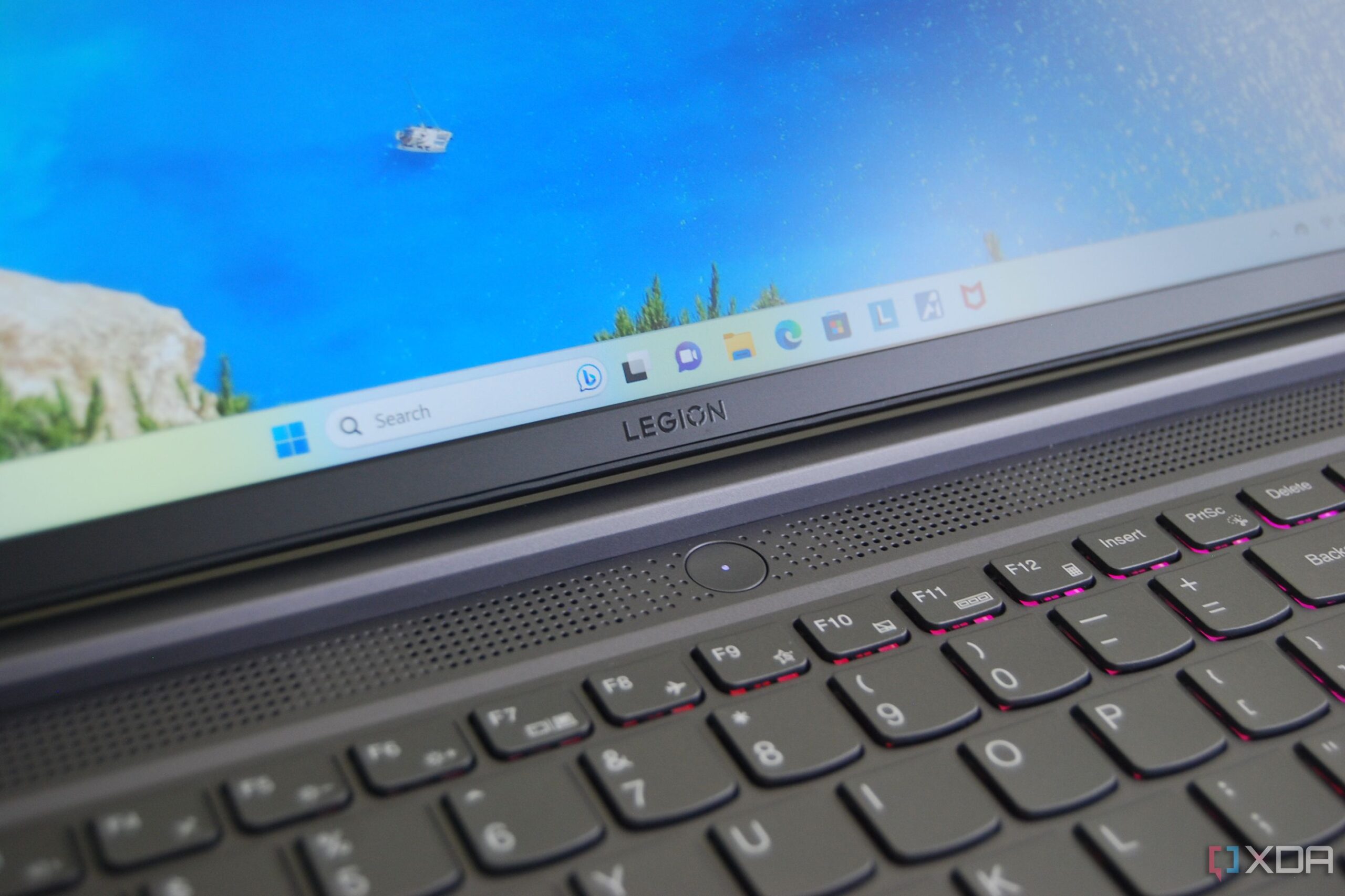
In this review, I’m testing the mid-range Slim 5 with AMD hardware. Lenovo also offers a Slim 5i with Intel hardware, as well as pricier Slim 7 and 7i options that bring a larger battery, full aluminum builds, extra security features, and more.
Looking at the official Lenovo website, the 16-inch Slim 5 (Gen 8) has a starting price of about $1,300. Due to Lenovo’s frequent and drastic price cuts, this introductory model is (at the time of writing) down to $1,075. This lands you an AMD Ryzen 5 7640HS CPU, Nvidia RTX 4050 Laptop GPU, 16GB of dual-channel DDR5-5600 RAM, a 512GB M.2 PCIe 4.0 NVMe solid-state drive (SSD), 1080p webcam, four-zone RGB keyboard, and 16-inch FHD+ display with 144Hz refresh rate. That’s a stacked deck for the asking price, but be sure you’re seeing a sizable discount before buying. Lenovo’s pricing is set up in a way that you’d be throwing money away by buying at full price.
My review unit has an AMD Ryzen 7 7840HS CPU, 16GB of dual-channel DDR5 RAM, a 512GB SSD, Nvidia RTX 4060 Laptop GPU, 1080p webcam, and QHD+ display with 100% sRGB color, Dolby Vision, and a 165Hz refresh rate. This exact model can also be found at Best Buy, starting at $1,530. At the time of writing, it’s been discounted to $1,230. Again, this is a lot of laptop for the asking price, but be sure you’re getting a discount when buying.
Design, ports, and keyboard
Plastic base, SD card reader, TrueStrike keys
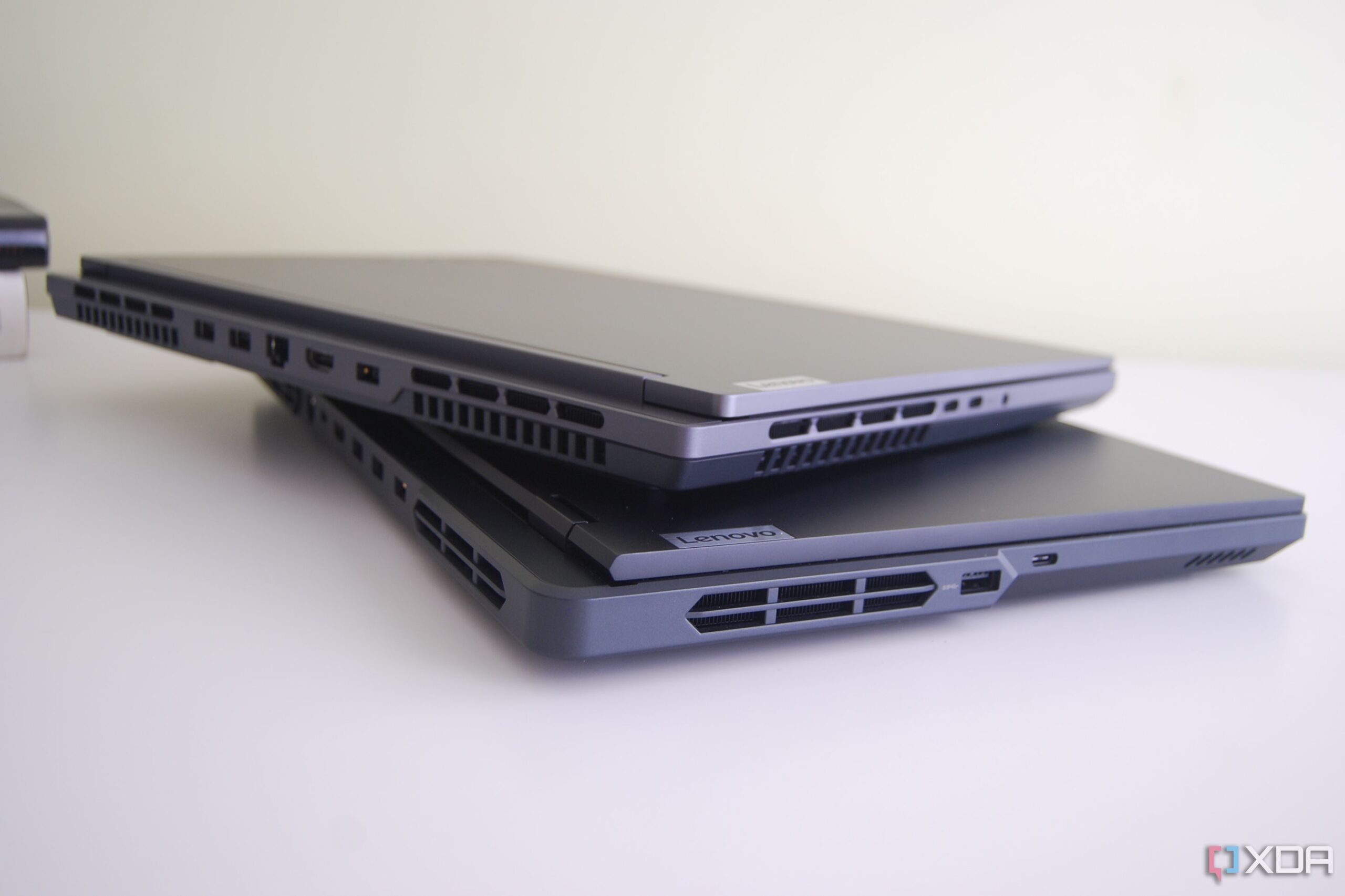
Slim 5 on top, Pro 5 below
While the Legion Pro series of laptops can’t exactly be considered thick or chunky, the Slim 5 focuses, as you can imagine, on portability. If we look at the AMD-based Lenovo Legion Pro 5 (2023) I also reviewed, it weighs in at about 5.5 pounds (2.5kg) and measures 14.31 x 10.25 x 0.88-1.05 inches (363.4mm x 260.35mm x 22.45-26.75mm). We can compare this to the Legion Slim 5 (2023)’s 14.16 x 10.25 x 0.78-0.99 inches (359.7mm x 260.3mm x 19.9-25.2mm) dimensions. The laptop also weighs less at about 5.29 pounds (2.4kg) compared to 5.6 pounds (2.55kg). It’s not a huge difference, but the design changes become more apparent when the laptops are sitting side by side.
The Legion Slim 5 has a modified exhaust setup with slimmer plastic accents on the sides and back. The bottom has a massive intake grille that remains uncovered thanks to some strategically placed rubberized feet. Some of the weight difference comes due to the use of PC/ABS plastic on the laptop’s base. This wouldn’t be a noticeable change if the base wasn’t so creaky when handled. In the same vein, the touchpad feels loose and a bit hollow when clicked, which wasn’t noticeable on the Pro laptops. It’s not a dealbreaker, but it’s something you’ll notice when you aren’t using a great gaming mouse. Aluminum is still used for the lid cover, resulting in a stiff screen without much flex.
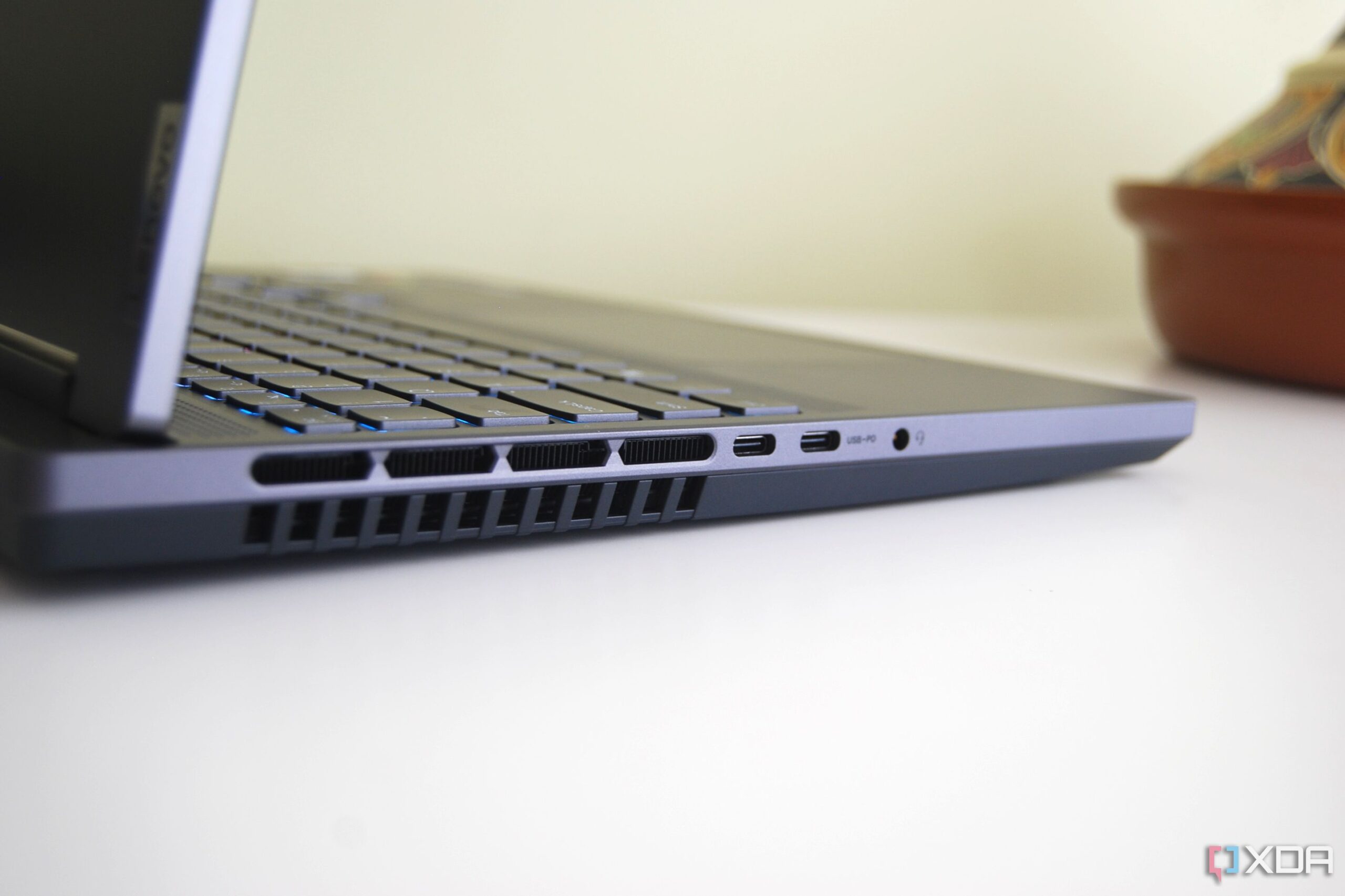
Ports are mainly situated along the back edge, installed in a sort of bank that juts out from the hinge point. There, you’ll find two USB-A 3.2 (Gen 2), RJ45 Ethernet, HDMI 2.1, and the proprietary AC connector. Two USB-C 3.2 (Gen 2) ports and a 3.5mm audio jack live on the left side of the laptop, while the right side has an SD card reader.
This is a straightforward port setup that covers most accessories, though the lack of Thunderbolt 4 due to the AMD platform might be felt by some users. You can still connect to a powerful docking station if you need more ports while tackling productivity or creative work. I tested the SD card reader to check the standard, and it appears to be using UHS-I. UHS-II performance is preferred, especially if you’re using the laptop beyond gaming, but it’s nice to have the option at all on a gaming laptop.
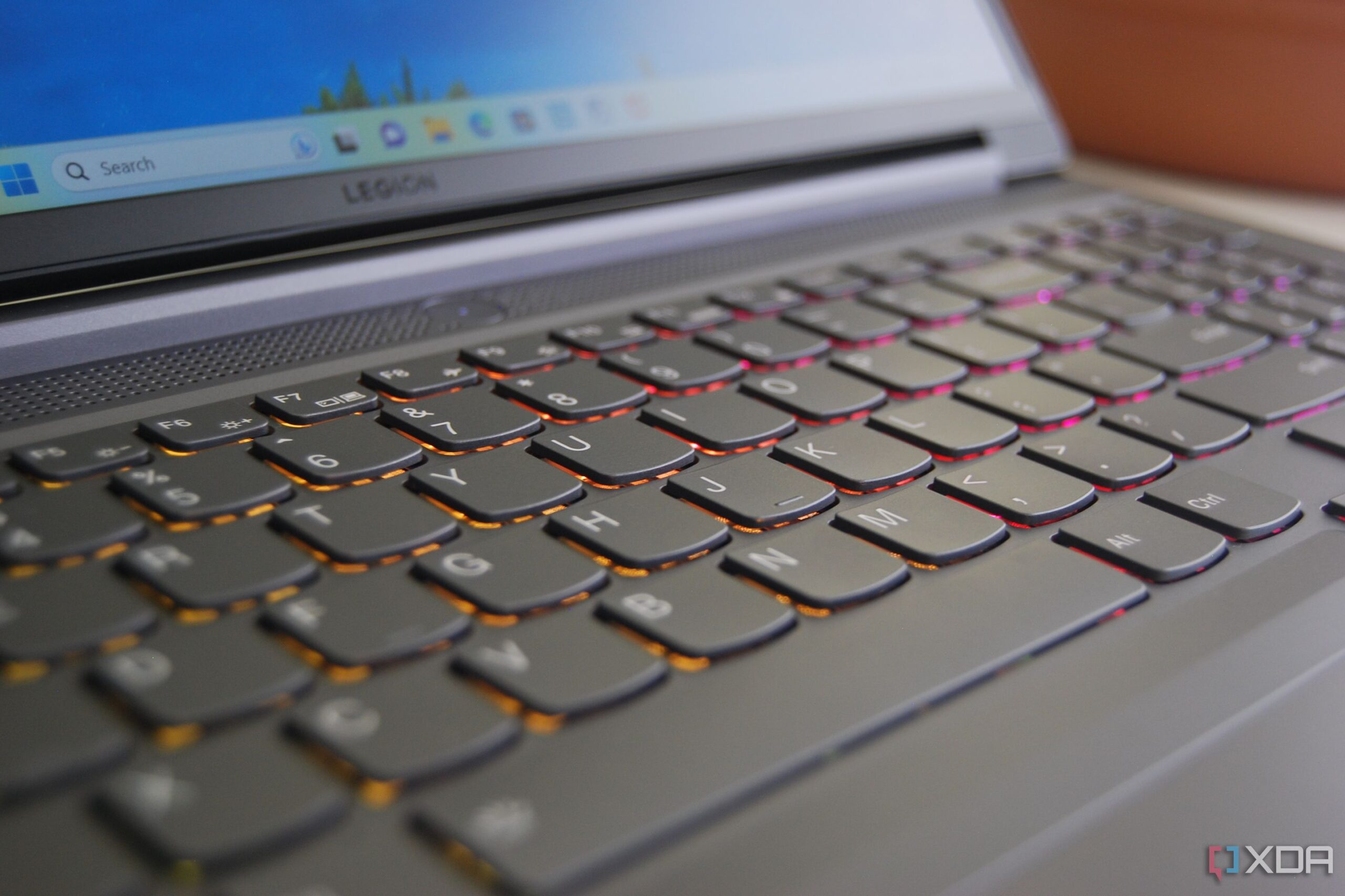
The TrueStrike keyboard is one we’ve seen before, this time with four-zone RGB lighting instead of per-key RGB. Keys have 1.5mm of travel for a comfortable typing experience, and the 100% anti-ghosting feature makes it a great option for gaming. Keycaps are slightly cupped, they have a firm actuation point, and there’s a bit of a tactile feel. You even get a number pad and individual keys for nav controls. This is, by all appearances, the exact same keyboard that you get in the higher-end Legion models. I primarily used the built-in keyboard while gaming on the Slim 5, but you can always add a great wireless gaming keyboard for marathon sessions.
Dual 2W speakers are built into the bottom of the chassis, facing down into your lap or desk. The angled design that we saw in the Pro 5 isn’t matched, so you’ll likely experience more severe muffling in certain situations. Nevertheless, the speakers get quite loud, and the smart amp gives a bit of bass rattle in music and in games. The best gaming headsets are still recommended for competitive gaming, but the stock audio here is quite good for casual gaming or for video conferencing.
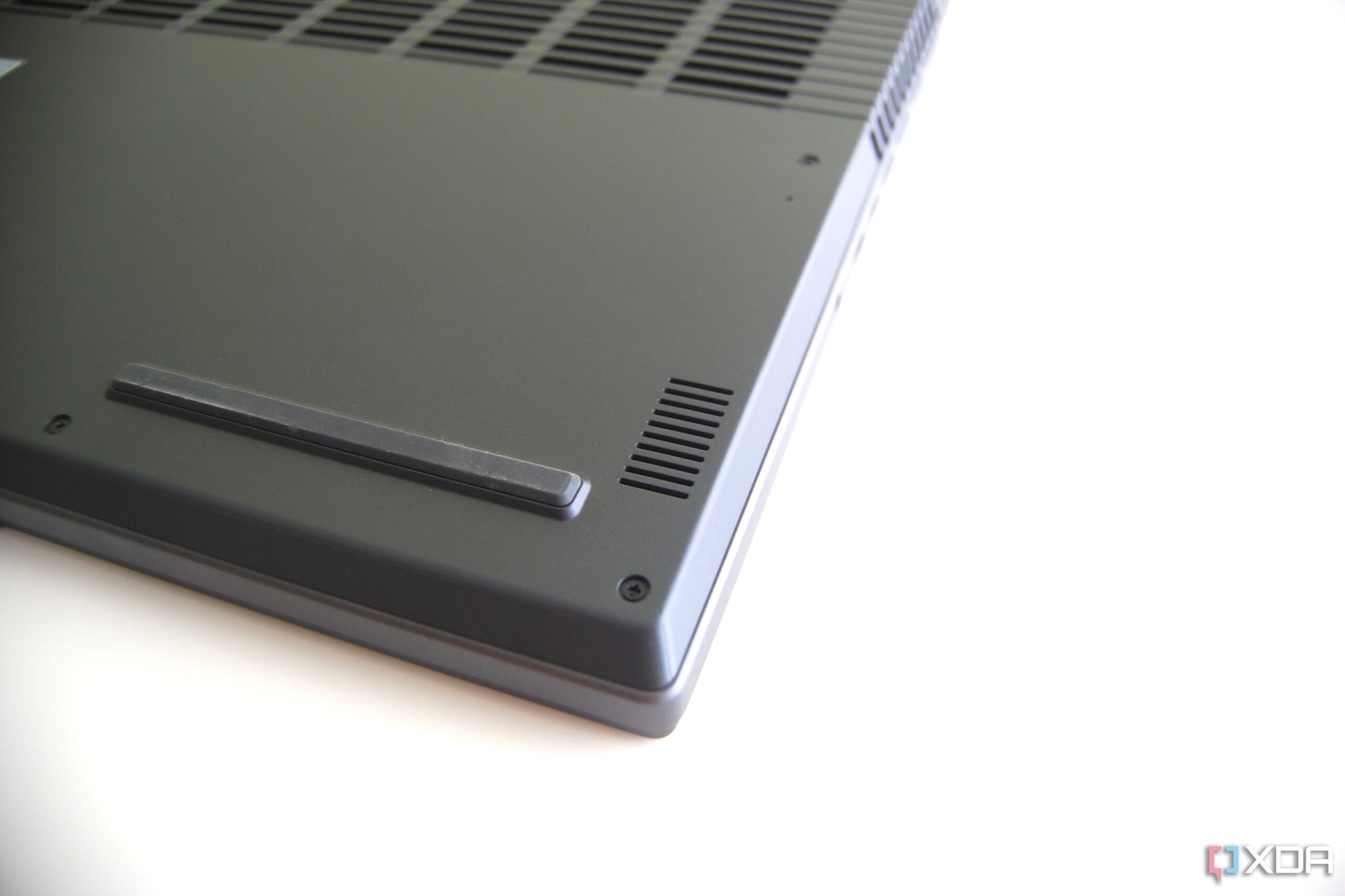
On that note, the front-facing 1080p webcam has the resolution required for quality streaming while gaming or while working. It deals well with bright backlighting and even has a killswitch on the right side should you want to kill the camera feed completely. The camera sits in a small reverse notch at the top of the display, making it easier to open with one hand.
As was first mentioned in my Lenovo Legion Pro 5i (2023) review, this generation of laptops offers some outstanding Wi-Fi speeds in part thanks to the dedicated Wi-Fi 6E M.2 card inside. Even when using a stock router, I saw the laptop max out my ISP’s throughput cap. That means you’ll wait around less for games to download as well as experience fewer issues when you aren’t using a wired connection.
Display
Three choices, up to QHD+ at 240Hz
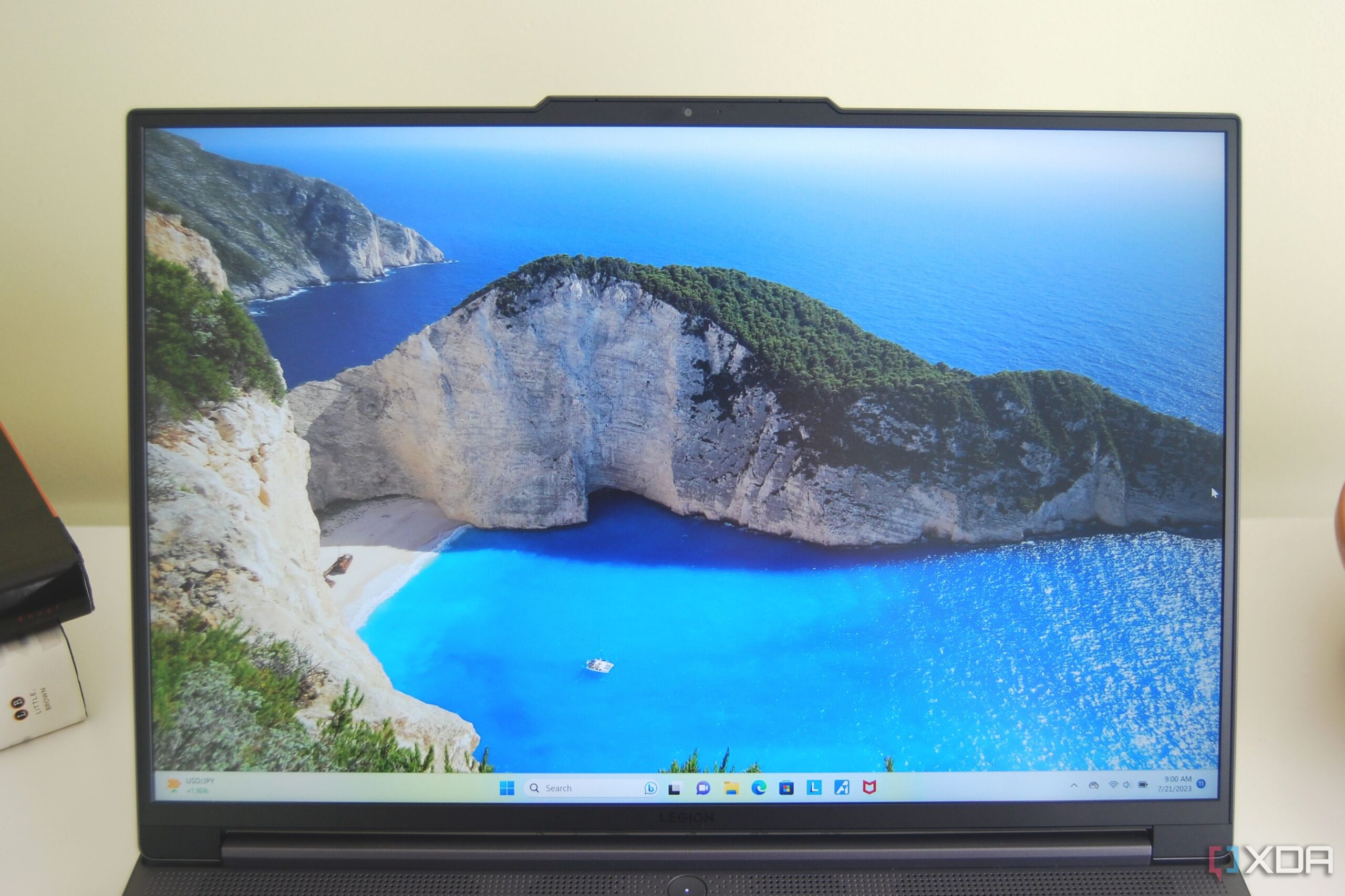
The current run of 16-inch screens that Lenovo is using with its Legion laptops is impressive. I’ve tested a few of these displays already, and the QHD+ version on my Slim 5 (Gen 8) appears to be the exact same as the one found on the Legion Pro 5 (Gen 8) I reviewed. You will notice some glare on the matte display due to the 330-nit maximum brightness, but it’s really only a problem when working or playing in a bright room. Anywhere else, you’ll get deep color and contrast made better by Dolby Vision for compatible content and TÜV low blue light certification to protect your eyes.
Testing with a SpyderX Pro colorimeter, I saw 100% sRGB, 76% AdobeRGB, and 80% DCI-P3 color coverage. You won’t likely want to use this screen for specialized work, but there is an X-Rite Pantone app that allows you to switch between sRGB and Rec. 709 color profiles. This is a gaming laptop first, and in that light, the display does a great job. It hits a 165Hz refresh rate which is more than enough to keep up with the RTX 4060 Laptop GPU, though you can make the jump to a 240Hz refresh rate with brightness up to 500 nits and DisplayHDR 400 certification.
Lenovo also lists an FHD+ screen with a 144Hz refresh rate in some documentation, though it seems to be tied with an RTX 3050 option that’s only available in a limited number of markets. The QHD+ screen, whether at 165Hz or 240Hz, is gorgeous and will do just fine for anything but competitive gaming where a large, high-end gaming monitor is required. If you’re comparing Legion Pro and Slim lineups, you don’t have to worry about an inferior display in the more affordable laptop.
To better suit hybrid use scenarios, an adaptive refresh rate toggle is available in the Lenovo Vantage app. When plugged in, the display sits at 165Hz. When on battery power, it drops automatically to 60Hz. You can still use Windows 11 settings to manually change the refresh rate, but this extra override can come in handy.
Performance
No throttling despite a thinner build
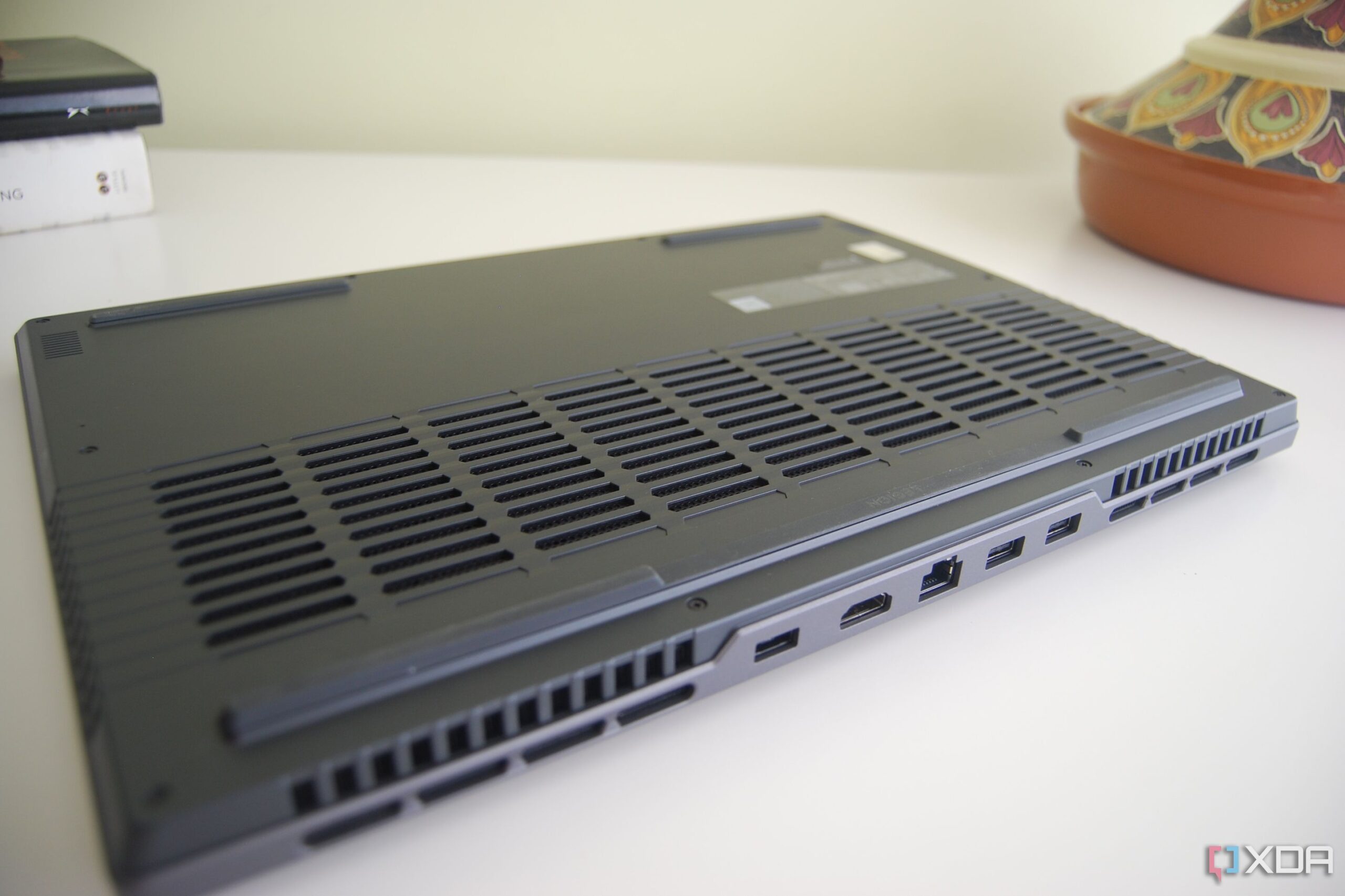
In the past, AMD-based laptops were prone to extreme performance slowdowns when running on battery power. This would make AMD laptops shine in terms of battery runtime, but users would find that CPU, GPU, and even the SSD were being hamstrung to boost numbers. That’s no longer an issue with AMD’s Ryzen 7000 mobile CPUs. Battery life is now much closer to Intel-based systems, with much better performance when the laptop is unplugged.
Putting aside DC performance numbers for the moment, we can see how the Ryzen 7 7840HS CPU compares on AC power to the more powerful AMD Ryzen 7 7745HX, Intel Core i7-13700HX, and Intel Core i9-13900HX chips in the Legion Pro laptops that we also reviewed. The Legion Slim 5 actually bested both of the Intel laptops in PCMark 10, and it even kept up quite well with the stronger HX-series chips in other synthetic benchmarks. The Nvidia RTX 4060 mobile GPU performed exactly as expected, and the system kept its cool in all scenarios.
| Benchmark | Lenovo Legion Slim 5 (Gen 8), AMD Ryzen 7 7840HS, RTX 4060 | Lenovo Legion Pro 5 (Gen 8), AMD Ryzen 7 7745HX, RTX 4070 | Lenovo Legion Pro 5i (Gen 8), Core i7-13700HX, RTX 4060 | Lenovo Legion Pro 7i (Gen 8), Core i9-13900HX, RTX 4080 |
|---|---|---|---|---|
| PCMark 10 | 8,172 | 8,531 | 7,370 | 7,570 |
| Cinebench R23 (single / multi) | 1,740 / 16,313 | 1,843 / 17,514 | 1,888 / 19,468 | 2,069 / 27,727 |
| Geekbench 5 (single / multi) | 1,800 / 10,669 | 2,028 / 12,269 | 1,832 / 14,990 | 2,074 / 20,806 |
| Geekbench 6 (single / multi) | 2,432 / 11,554 | 2,641 / 12,749 | 2,480 / 13,524 | 2,760 / 16,745 |
| 3DMark Time Spy | 10,738 | 12,097 | 11,031 | 17,722 |
| 3DMark Time Spy Extreme | 5,039 | 5,705 | 5,167 | 8,892 |
To prove how little difference there is now in terms of AMD performance on AC and DC power, I also ran some of the above tests with the laptop unplugged. The Legion Slim 5 managed a 7,085 score in PCMark 10, with hardly any difference in Geekbench 5 and 6 for single-core scores. Multi-core scores dipped a bit — 100 points in Geekbench 5 and 300 points in Geekbench 6 — but not enough to really be noticeable in everyday use.
You’re still going to want to keep your AC charger nearby when gaming, as the laptop only lasted for about 47 minutes in PCMark 10’s Gaming rundown test. With the display set to a 60Hz refresh rate with about 75% screen brightness, I saw more than four hours of runtime in PCMark 10’s Modern Office rundown. Manually turning off the discrete GPU (aka disabling Nvidia Optimus), lowering the screen resolution, and dropping the brightness further would provide even more runtime on DC power. Not bad at all for a gaming laptop.
Lenovo likes to emphasize its onboard AI chip, which tunes performance and thermals. This is for a good reason; I’ve yet to test a modern Legion laptop that throttles due to heat, even under a full-system stress test. I ran the test on the Legion Slim 5 for 15 minutes without any surprises. Instead of letting all components run to their full potential and be throttled by thermals, the Lenovo system automatically kept the GPU at 75W and the CPU at 45W (just below their full potential).
The GPU and CPU topped out at 89 degrees and 82 degrees Celsius, respectively. This is an extreme example, and in real-world gaming, I never noticed the laptop get too hot under the keyboard. I also measured a maximum of 56dB of fan noise with the system under full load. The Slim 5 might be thinner than the Pro laptops, but it really doesn’t produce any more noise or heat.
I also made sure to test a bunch of demanding games to see how well the system’s hardware performs in a real-world situation.
| Game | Graphics setting | Legion Slim 5 (Gen 8) Average frame rate | Legion Pro 5 (Gen 8) Average frame rate | Legion Pro 5i (Gen 8) Average frame rate |
|---|---|---|---|---|
| Red Dead Redemption 2 | Ultra (favor quality) / No DLSS | 58 FPS | 66 FPS | 58 FPS |
| Red Dead Redemption 2 | Ultra (favor quality) / DLSS Performance | 79 FPS | 90 FPS | 82 FPS |
| Shadow of the Tomb Raider | Highest / No DLSS | 83 FPS | 94 FPS | 96 FPS |
| Shadow of the Tomb Raider | Highest / DLSS Performance | 131 FPS | 157 FPS | 146 FPS |
| Far Cry 5 | Ultra / No DLSS | 92 FPS | 104 FPS | 93 FPS |
As we can see from the frame rates above, you will lose a bit of potential from the HS-series chip when compared to HX-series chips. The Legion Pro 5 (Gen 8) also has a faster RTX 4070 laptop GPU that boosts its numbers. When compared to the Legion Pro 5i (Gen 8) with Core i7-13700HX and RTX 4060, the performance is much closer. These tests were performed at the full QHD+ resolution, meaning you’ll be able to eke out some extra frame rates at a lower resolution if required.
Should you buy the Lenovo Legion Slim 5 (2023)?
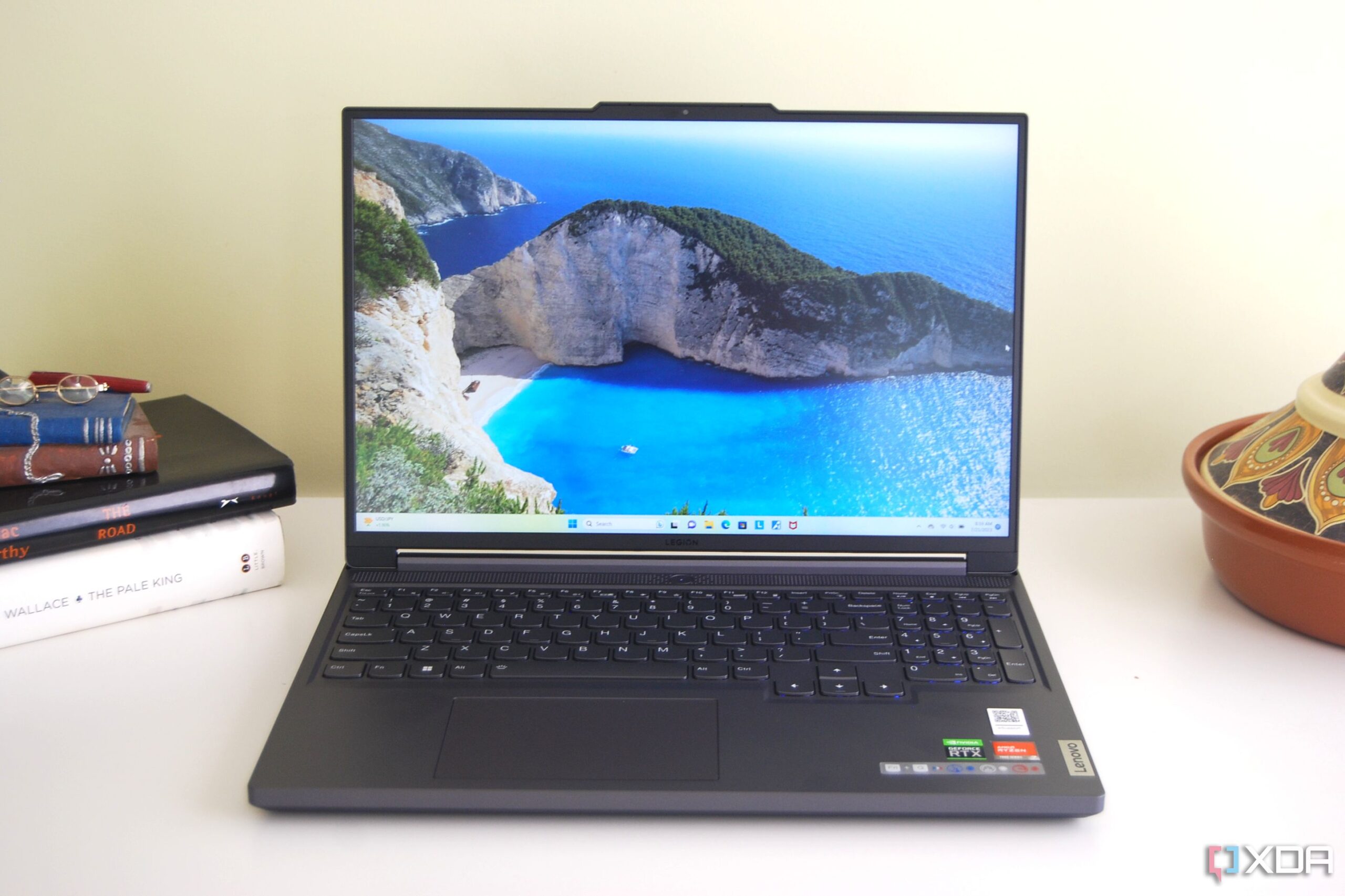
You should buy the Lenovo Legion Slim 5 (2023) if:
- You’d like a gaming laptop that’s less bulky than a Legion Pro
- You need a laptop that can function for gaming and for productivity (especially creative tasks)
- You want a gaming laptop that can handle modern games at smooth framerates
You should not buy the Lenovo Legion Slim 5 (2023) if:
- You want the most performance possible from a gaming laptop
- You want a built-in 4K display
We have now tested a handful of Lenovo’s eighth-generation Legion gaming laptops, and it’s safe to say that you’re going to get one of the best laptops around, regardless of the model. While the Legion Pro laptops offer the best performance and the most premium features, the Legion Slim laptops are not far behind. You will have to make some compromises in terms of build quality, but it doesn’t look like performance is really hindered at all in the more compact chassis. The Ryzen 7 7840HS chip compares very well to the Core i7-13700HX despite having half the amount of cores and eight fewer threads.
Lenovo leaned more into a hybrid use case with the Slim laptops. They’re easier to carry around if you’re heading into an office, they have an SD card reader for easier use of removable storage, and their CPU options require less power for longer battery life. There are plenty of great Lenovo laptops out there, but the Legion Slim 5 (Gen 8) should be particularly attractive to gamers who love to create and want just one laptop for all purposes.

Source: Lenovo
Lenovo Legion Slim 5 16 (Gen 8)
Sleek but powerful gaming laptop
$1075 $1300 Save $225
Lenovo’s Legion Slim 5 (Gen 8) for 2023 a thinner alternative to the Legion Pro lineup that serves as a bridge between gaming and creative work. It brings excellent performance and gorgeous display options, though you will have to live with fewer premium features compared to the Pro series.
